By: Matthew P. Funaiole, Brian Hart, Joseph S. Bermudez Jr., and Samantha Lu
November 21, 2023
Work continues apace on a rapid buildup of the Chinese People’s Liberation Army Navy (PLAN). Two shipyards in Shanghai—Jiangnan Shipyard and Hudong-Zhonghua Shipyard—are at the heart of the country’s naval modernization. Recent commercial satellite imagery shows significant progress on China’s third aircraft carrier, a new Type 075 amphibious assault vessel, and several other vessels.
Developments at Jiangnan Shipyard
Situated on the sprawling industrial hub of Changxing Island, Jiangnan Shipyard is a leading player in Chinese commercial and naval shipbuilding. The shipyard is perhaps most famous for constructing China’s third aircraft carrier, the Type 003 Fujian, but recent satellite imagery reveals other key vessels in the works as well.
ChinaPower has tracked the Fujian using satellite imagery since 2018. Since our team last analyzed the carrier in June 2023, the shipyard has made notable progress on the vessel, which is moored in the main large basin of the shipyard. Imagery from October 17, 2023, shows workers have taken the long-expected step of removing the environmental shelters covering the ship’s three catapults, indicating that primary work on the systems is completed.
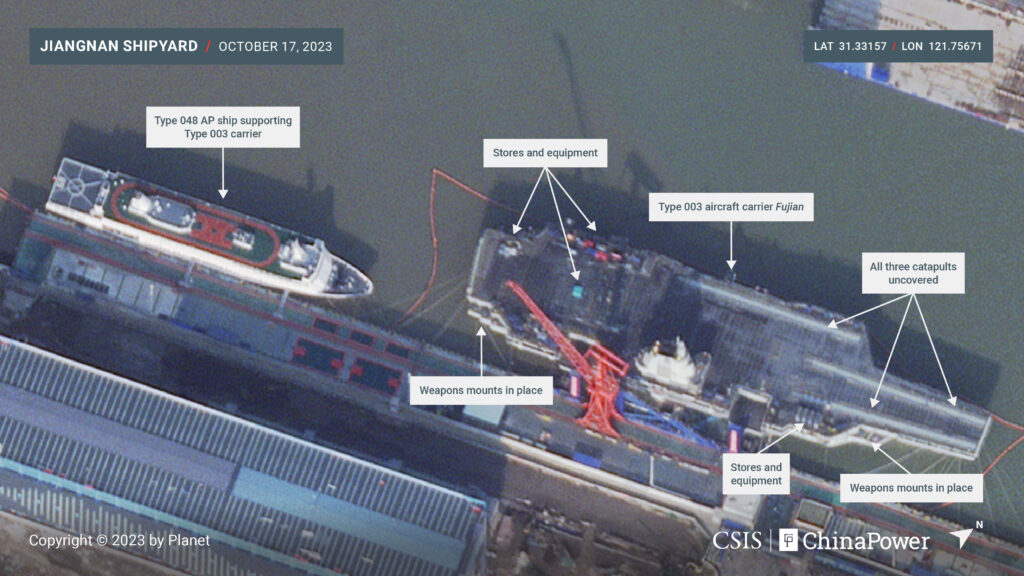
Click to enlarge
These catapults are the most anticipated upgrade over China’s first two carriers, the Liaoning and Shandong, which rely on less advanced ski jump-style “short take-off, barrier-arrested recovery” (STOBAR) systems. The Fujian features a “catapult assisted take-off but arrested recovery” (CATOBAR) launch system that will enable it to launch heavier and larger fixed-wing aircraft with greater fuel and weapons loads.
Furthermore, China leapfrogged more traditional steam-powered catapults by outfitting the Fujian with an electromagnetic catapult launch system like that featured on the U.S. Navy’s new Gerald R. Ford-class of carriers. These systems are designed to enable faster takeoffs, increase energy efficiency, and reduce stress on aircraft frames during takeoffs.
In addition to making progress on the catapults, workers have installed weapons mounts on designated areas of the vessel’s decks, although it is unclear whether the weapons themselves have been installed. These are expected to include close-in weapons systems, short-range air defense missiles, and anti-submarine rocket launchers.
Adjacent to the carrier is a Type 048 auxiliary personnel (AP) ship—a class of vessel used to house the cohort of workers testing and fitting out the carrier. During the construction of China’s other carriers, the arrival of these vessels typically heralded manufacturer sea trials. The positioning of the AP ship directly behind the Fujian thus suggests its sea trials will kick off soon.
The carrier will undergo multiple rounds of manufacturer trials to test the hull’s soundness and maneuverability. Once handed over to the PLAN, sailors will conduct their own trials of its weapons, aircraft launch systems, and other capabilities in a process that will take months or even years.
Nearby, in Jiangnan’s floodable basin, workers are busy building and fitting out other key vessels. On the basin’s western edge is a large ship belonging to the Yuanwang-class of tracking ships.1 Recent posts by the shipyard’s owner, China State Shipbuilding Corporation (CSSC), confirm that this vessel will be part of the Yuanwang-class. In July 2023, the CSSC 708th Research Institute announced it had completed a slipway ceremony for a new vessel that will “carry forward ‘Yuanwang spirit’” (弘扬“远望精神”). The vessel has not yet been named but could be dubbed the Yuanwang-8.
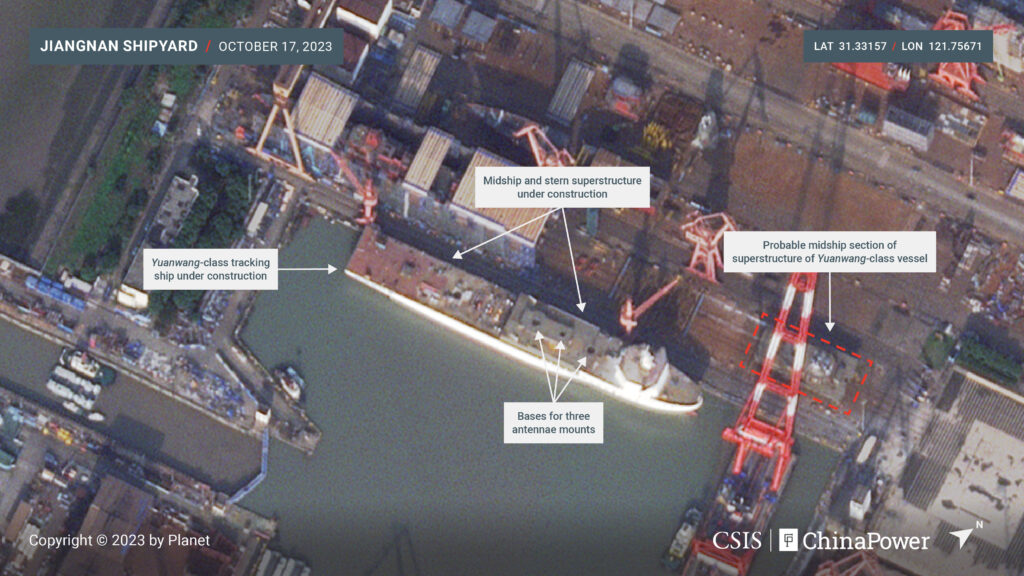
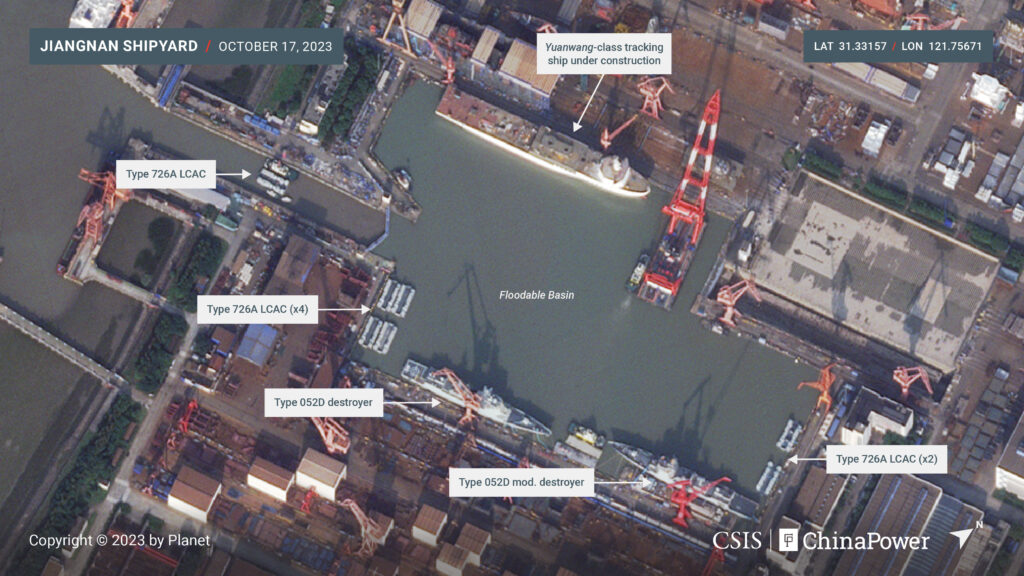
Equipped with advanced electronic equipment, sensors, and antennae, these ships enable the PLA Strategic Support Force to track satellites as well as rocket and missile launches. The equipment on these ships can also support surveillance-gathering. In 2022, the Yuanwang-5 docked at the Chinese-operated Port of Hambantota in Sri Lanka for a week, drawing protest from neighboring India over concerns of spying.
The vessel under construction at Jiangnan measures approximately 224 meters in length, which is consistent with other third-generation Yuanwang ships. The ship’s superstructure, which remains unfinished, features three bases to support the large antennae that will be installed in the future. On the ground near the vessel is a large component of the ship’s midsection superstructure, which will eventually be lifted by a large barge crane and fitted onto the hull.
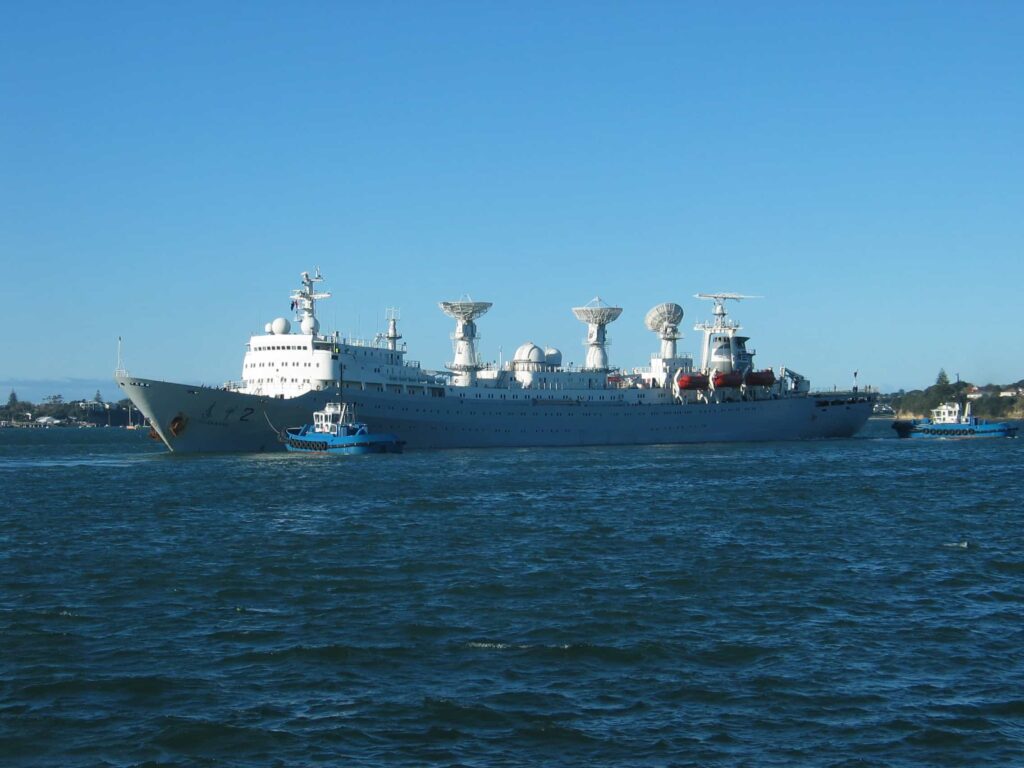
Yuanwang-2 ship in Waitemata Harbour, Auckland, New Zealand. Source: Wikimedia Commons
Also in the floodable basin are two Type 052D destroyers being fitted out. One of the two is a modified version with an extended helicopter landing deck at the ship’s stern. Jiangnan Shipyard has been a key builder of these and other destroyers, which are an essential element of China’s growing naval prowess.
Developments at Hudong-Zhonghua Shipyard
Across the sprawling Yangtze River in the heart of Shanghai, Hudong-Zhonghua Shipyard is similarly bustling with activity. Most significantly, satellite imagery from October 26, 2023, shows rapid progress on construction of a Type 075 amphibious assault ship.
Satellite imagery shows the hull of the Type 075 in one of the shipyard’s main large drydocks. The hull blocks of the vessel have already been assembled, and work on the superstructure appears to be underway. In the October 26 images, the vessel’s “island” had not been installed, but ground-level images circulating on social media suggest the island was put in place in early November.
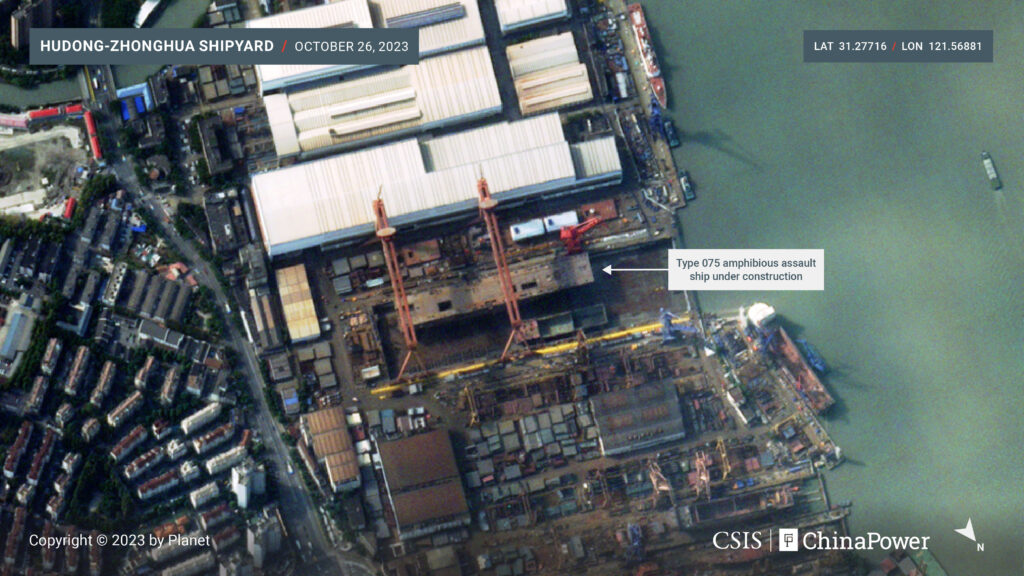
The Type 075 is one of the largest surface combatants in the PLAN. Capable of carrying a large number of troops, amphibious landing craft, armored vehicles, and helicopters, the Type 075 is a critical platform for enhancing the PLAN’s capacity to conduct amphibious landings against Taiwan and long-range expeditionary operations farther from China’s shores.
China has already commissioned three Type 075s in recent years, all of which were constructed together at Hudong-Zhonghua shipyard as part of an initial batch. The new Type 075, which likely began construction in early 2023, will be China’s fourth.
This new Type 075 could be a standalone vessel, but some sources have suggested it is the first in a second batch of three more Type 075s hulls. If China builds a contingent of six, the PLAN would shrink the gap with the U.S. Navy’s nine similar vessels (currently two America-class and seven Wasp-class ships).
Also visible at the shipyard are three other military vessels: two Type 054A frigates and one Type 054B frigate. Of these, the Type 054B stands out for its novelty.
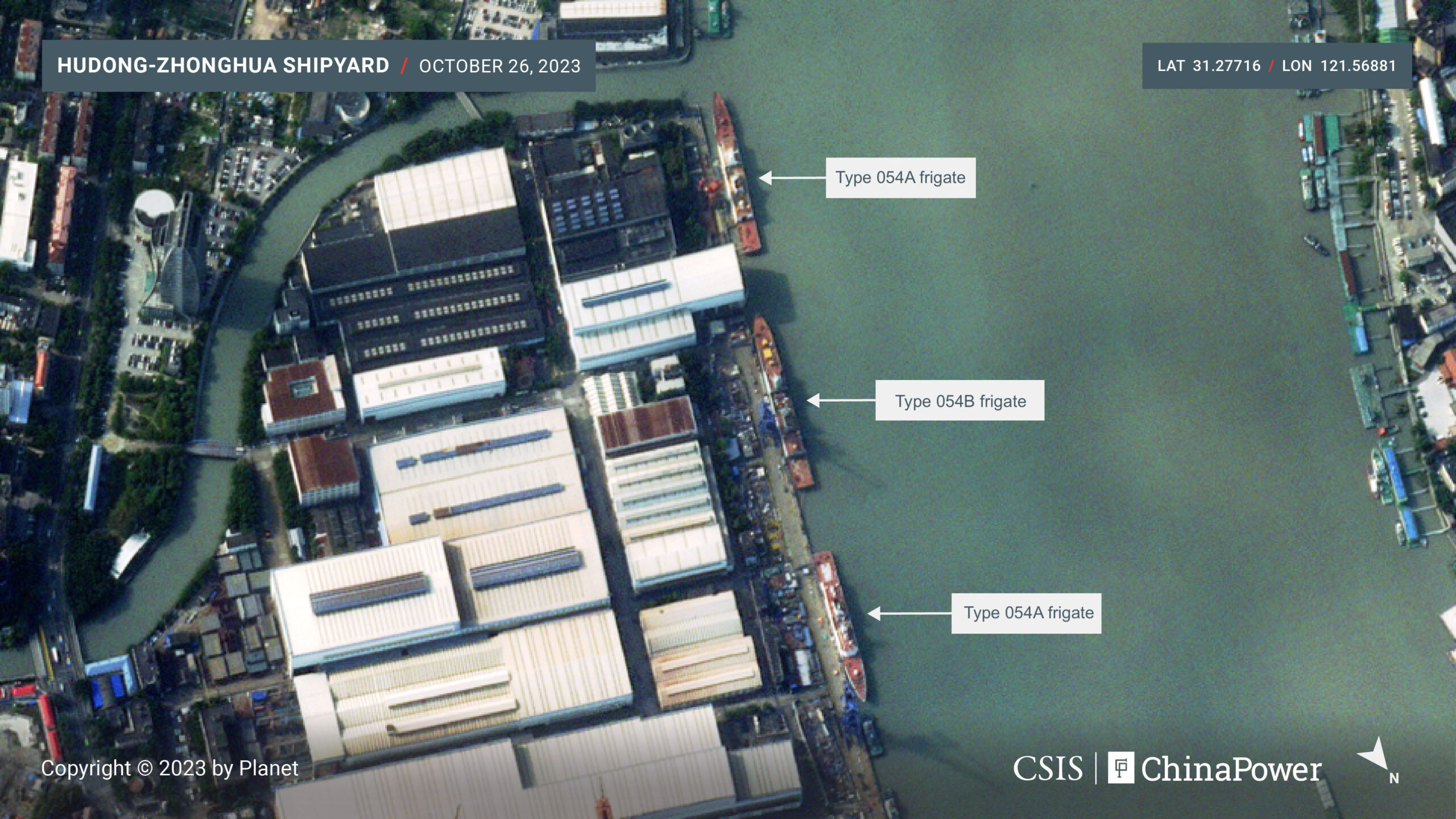
The new ship is the first vessel in a significantly redesigned version of the existing Type 054A frigate. Launched in August 2023, the ship’s displacement may be as much as 50 percent greater than that of the Type 054A ships currently in service. The Type 054B is equipped with a dual-face active phased array radar system, providing enhanced situational awareness and air defense capability.
Unlike the diesel-powered Type 054A, the new frigate is also thought to be powered by gas turbines, giving it greater operational range. Song Zhongping, a military affairs commentator and retired PLA officer, stated that the new Type 054B will be optimal for operations that are “far from Chinese coasts, and will better fit an escort role in an aircraft carrier battle group.”
Even as shipbuilding activity continues at Hudong-Zhonghua, work is underway to move the shipyard to new facilities on Changxing Island, directly adjacent to Jiangnan Shipyard. Once completed, the consolidated facilities there will cement Changxing Island’s status as the unrivaled epicenter of China’s shipbuilding industry. 
Note: This article originally referred to the Type 048 AP ship as the Xu Xiangqian. There is a Type 048 ship named Xu Xiake; however, that is hull number 88. The vessel shown in imagery on this page is hull number 89. Additionally, original images of Hudong-Zhonghua Shipyard mislabeled the location of the Type 054B. This issue has been corrected.
